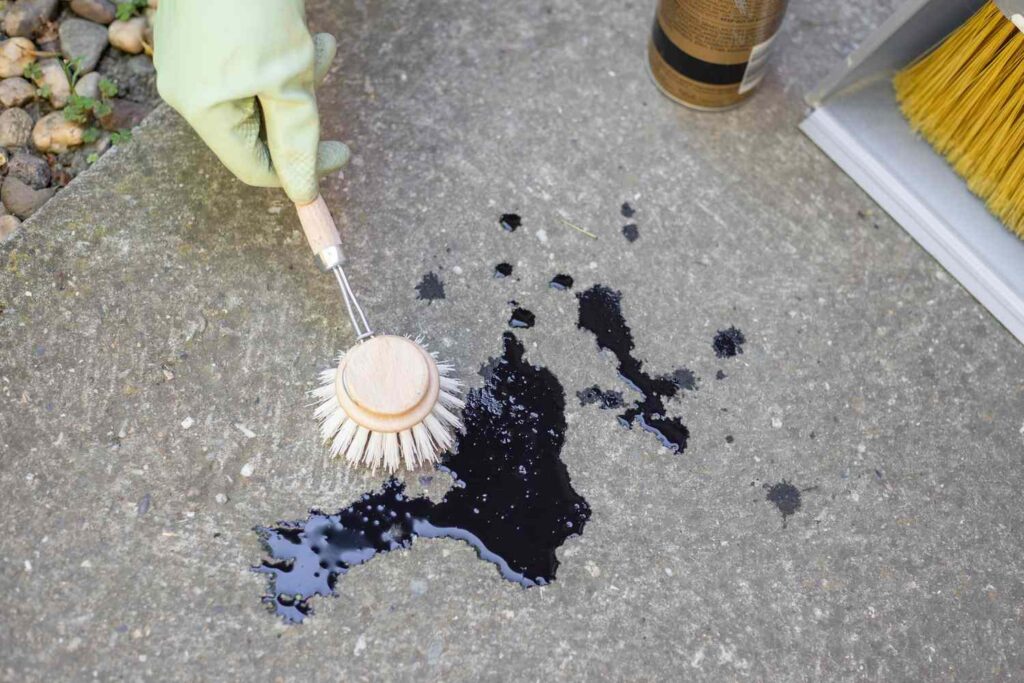Hydraulic oil stains on unsealed concrete can be a nightmare. Once oil seeps in, it penetrates deep into the pores, leaving dark, greasy spots that resist regular cleaning.If you’re dealing with old or set-in stains, this step-by-step guide will help you remove them effectively without damaging the surface.
Why Unsealed Concrete Is So Prone to Staining
Unlike sealed concrete, unsealed surfaces absorb oil almost instantly. In industrial settings like warehouses, garages, or outdoor driveways, spills often go unnoticed for hours—making cleanup harder.
👉 New to the topic? Start with this beginner guide:
How to Remove Hydraulic Oil from Concrete
What You’ll Need
- Heavy-duty degreaser (alkaline or solvent-based)
- Absorbent material (e.g., kitty litter or oil-dri granules)
- Plastic sheeting (for dwell time)
- Stiff nylon scrub brush
- Optional: Poultice paste for deeply set stains
Step-by-Step: Cleaning Set-In Hydraulic Oil

1. Start with a Dry Absorbent
- Pour dry absorbent over the stained area
- Let sit for several hours (overnight is ideal)
- Sweep up and dispose responsibly
This removes any remaining surface-level oil.
2. Apply a Powerful Degreaser
- Choose a concrete-safe, heavy-duty degreaser rated for petroleum-based oils
- Apply generously and allow a 15–30 min dwell time
- Cover the area with plastic sheeting to slow evaporation for deeper penetration
3. Scrub and Rinse Thoroughly
- Use a stiff bristle brush (never metal on concrete)
- Scrub in circles, focusing on stained zones
- Rinse with hot water or a pressure washer
Repeat if the stain still appears after drying.
👉 Need a list of top degreasers? You’ll find it in:
Best Degreasers for Motor Oil on Concrete – Product Review
(Many are effective on hydraulic oil too.)
4. Use a Poultice for Deep Stains (Optional)
For deeply embedded oil:
- Mix absorbent material + degreaser to form a thick paste
- Spread over the stain and cover with plastic wrap
- Let it dry completely (usually 12–24 hours)
- Scrape off and rinse
This draws oil out from inside the concrete pores.
Pro Tip: Seal It After Cleaning
If you leave concrete unsealed, you’ll likely face the same issue again. After deep cleaning:
- Let the surface dry for 48–72 hours
- Apply a penetrating or topical concrete sealer
Sealing helps avoid repeat stains from motor oil, hydraulic oil, or even cooking oil spills.
👉 See this post for long-term protection tips:
How to Prevent Motor Oil Stains on Your Driveway or Garage Floor
When It’s Time to Hire a Professional
There’re few things you need to try before hiring the professional:
- You’ve tried multiple cleanings with no improvement
- The stain covers a large commercial area
- Environmental safety is a concern
…it may be best to consult a professional with industrial cleaning tools.
👉 Wondering if you should DIY or hire help? Here’s a useful comparison:
DIY vs Professional Concrete Oil Stain Removal – Which is Better?
FAQs – Cleaning Old Hydraulic Oil from Concrete
Q1: Will pressure washing alone remove old stains?
No. Pressure washing can help rinse out degreasers, but without pre-treatment, it won’t lift set-in oil.
Q2: Are old stains permanent?
Not always. With the right degreaser and technique (like a poultice), even deep stains can be greatly reduced or eliminated.
Q3: What’s the safest method for outdoor concrete?
Use biodegradable degreasers and avoid runoff into drains. Sweep up dry absorbents thoroughly before rinsing.



